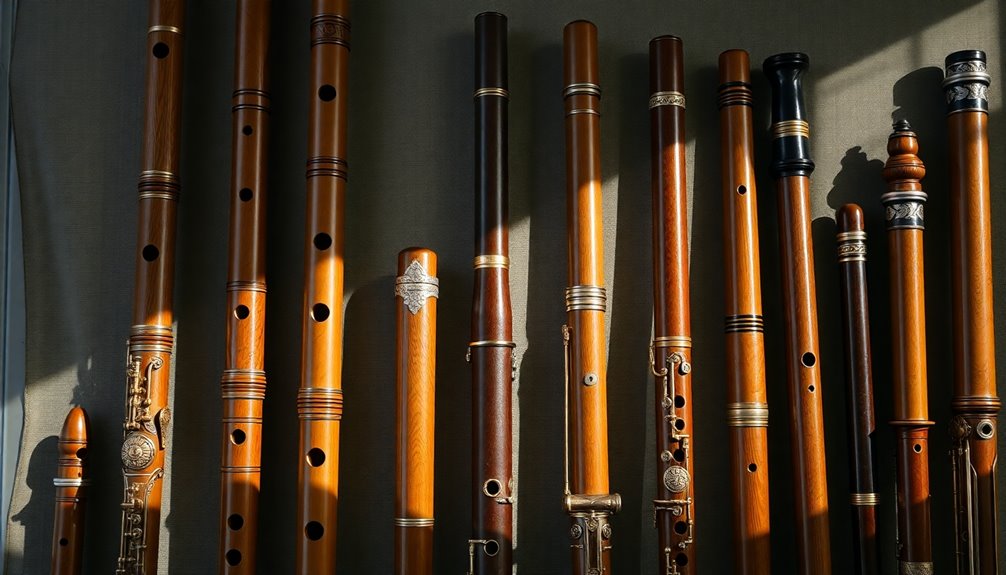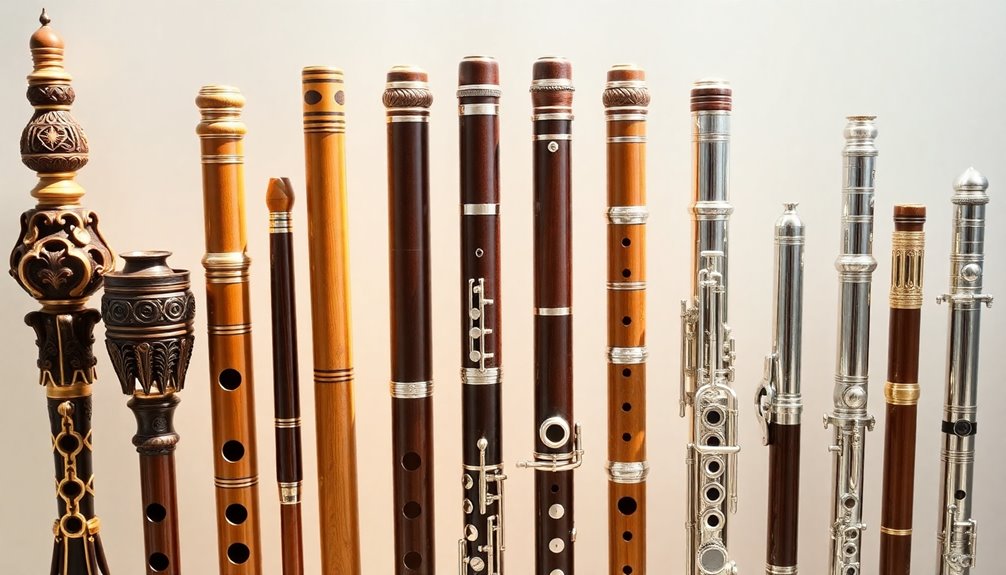The flute's design has undergone a remarkable evolution, reflecting both technological advancements and cultural shifts. Starting from ancient wooden and bone constructions, it progressed through the Renaissance's cylindrical wooden flutes and Baroque conical designs that enriched tonal quality. You'd notice the 19th-century introduction of metal flutes, which improved durability and sound clarity, alongside the revolutionary Boehm system enhancing playability and ergonomics. Today, modern flutes incorporate advanced materials and electronic elements, expanding their versatility across genres. This intricate history highlights the flute's ongoing adaptability and significance in music. You might find it fascinating to explore how these changes shaped the instrument's role over centuries.
Key Takeaways
- The flute originated in ancient civilizations, evolving from basic materials like wood, bone, and bamboo to more sophisticated designs.
- The Renaissance introduced the wooden flute with a cylindrical body, enhancing its tonal quality and playability.
- Baroque flutes featured a conical shape, enriching tonal richness and expanding expressive capabilities.
- The 19th century saw the transition to metal flutes, with the introduction of the Boehm system revolutionizing key placement and ergonomics.
- Modern advancements include electronic elements and CAD technology, allowing for improved sound quality and manufacturing consistency.
Ancient Flute Designs

Throughout history, ancient flute designs frequently reflected the cultural and technological advancements of their time. When you investigate these early instruments, you'll notice how they often utilized prehistoric materials such as bone, wood, and even reeds. These materials weren't just practical choices; they served a deeper cultural significance. The way a community crafted its flute spoke volumes about its identity, beliefs, and the environment they inhabited.
Consider the simple yet elegant designs of flutes from prehistoric societies. Each flute carried with it the fingerprints of its maker, embodying the traditions and stories passed down through generations. As you explore the craftsmanship, you'll see that the intricate carvings and shapes weren't mere embellishments. They often held symbolic meanings, connecting the music produced to the spiritual beliefs or social functions of the time.
Moreover, the technological advancements of the era influenced how musicians approached sound production. The evolution from basic wind instruments to more sophisticated designs illustrates humanity's quest for innovation. From the rudimentary finger holes to the development of more complex mechanisms, every advancement represented a shift in not only musical expression but also social cohesion. The introduction of materials like silver and gold allowed for a richer tonal quality, enhancing the overall flute experience.
Medieval Flute Innovations

In the context of the medieval period, flute innovations marked a significant turning point in both design and musical expression. Unlike their ancient predecessors, medieval flutes began to utilize a variety of materials, enhancing their sound and playability. Craftsmen experimented with wood types such as boxwood and maple, which provided a warmer tone, while metal elements occasionally featured in finer instruments.
These advancements didn't just change the flute's construction; they also influenced the techniques you'd use while playing. As flutists explored new fingerings and breath control methods, they could create a wider range of dynamics and expressiveness. This period was a time of discovery, where musicians closely observed one another, fostering a culture of collaboration and growth.
Here's a glimpse into the evolution of flute innovations during the medieval era:
| Innovation | Description | Impact on Music |
|---|---|---|
| Material Diversity | Introduction of various woods and metals | Richer tonal qualities |
| Finger Technique | Development of new fingerings | Greater expressive range |
| Embouchure Changes | Experimentation with mouth shapes | Enhanced projection |
These innovations not only improved the instrument but also united musicians in a shared pursuit of mastery. By embracing these changes, you become part of a lineage that values creativity, expression, and connection through music. The medieval flute, with its evolving materials and techniques, laid the groundwork for future generations, inviting you to explore and contribute to this rich musical heritage. The exploration of different types of flutes during this time further enriched the musical landscape, allowing for more diverse compositions and performances.
Renaissance Flute Characteristics

During the Renaissance, flutes underwent remarkable transformations, both in design and functionality, reflecting the era's artistic ideals and advancements in craftsmanship.
You'd notice that Renaissance flutes were typically made of wood, with common materials including boxwood and grenadilla. These choices not only enhanced the instrument's aesthetic appeal but greatly influenced its tonal quality. The craftsmanship of the time emphasized both beauty and utility, leading to flutes with a more refined finish compared to their Medieval predecessors.
The design of the Renaissance flute featured a cylindrical bore, which contributed to a more focused and clear sound. Unlike earlier flutes, which often had a conical shape, this change allowed for better intonation and easier playability across different registers.
You'd also find that the number of finger holes increased, facilitating a broader range of notes and making the instrument more versatile for various musical styles.
In addition, the introduction of a tuning slide became common, allowing musicians like you to adjust pitch more easily. The keyless design remained prevalent, emphasizing the need for skilled finger dexterity.
With the Renaissance focusing on individual expression, the flute's capabilities expanded, inviting a more personal connection between the musician and the music. This evolution in design and functionality aligns with the importance of expert advice in the selection process, ensuring that players could find instruments suited to their skill level and preferences.
Baroque Flute Advancements

Baroque construction techniques played an essential role in enhancing the instrument's overall sound and playability. Flutes began using wood materials like grenadilla and boxwood, which provided richer tones compared to the earlier models.
The addition of a single key allowed for greater versatility in playing, enabling you to access a broader range of notes without compromising intonation.
Moreover, the design of the flute during this era featured wider finger holes, allowing for improved finger placement and faster passages. These adjustments not only made the instrument more responsive but also catered to the intricate embellishments characteristic of Baroque music.
The baroque ornamentation styles became vital, as performers were expected to add personal flair to their interpretations. Techniques like trills, appoggiaturas, and mordents became integral to the art of flute playing, showcasing your individuality and musicality.
Furthermore, these advancements laid the groundwork for future innovations, such as the open-hole design that enhances control over dynamics and timbre.
Modern Flute Technology

As advancements in materials and manufacturing techniques emerged, modern flute technology transformed the instrument into a highly precise and versatile tool for musicians. Today, flutists benefit from innovative material choices that enhance both sound quality and durability. For instance, silver, gold, and even platinum are now common in professional flutes, allowing for a rich tonal palette and improved resonance.
Additionally, digital flute enhancements have revolutionized how you can interact with your instrument. These technologies enable real-time monitoring of pitch and tone, providing immediate feedback on your playing. This integration of technology into traditional craftsmanship fosters a deeper connection between you and your instrument, offering a personalized experience that was once unimaginable. Furthermore, the use of high-grade stainless steel in flute construction contributes to their durability and sound integrity.
| Feature | Description |
|---|---|
| Material Choice | Use of silver, gold, and other metals for better sound quality and durability. |
| Digital Enhancements | Real-time monitoring for pitch and tone, enhancing practice and performance. |
| Key Mechanism Innovations | Improved key design for better ergonomics and playability. |
Through these advancements, the modern flute accommodates a wide range of musical styles and preferences. Whether you're performing classical pieces or exploring contemporary genres, the flute's evolution means you can express your artistry in ways that resonate with both you and your audience. The blend of tradition and technology not only enriches your playing experience but also fosters a sense of belonging within the vibrant community of flutists.
Frequently Asked Questions
What Materials Were Commonly Used in Ancient Flute Construction?
When you explore ancient flute construction, you'll find that wooden flutes were quite common, crafted from materials like bamboo and hardwoods.
These natural elements offered a warm, rich tone. In contrast, some cultures began experimenting with metal alloys, which provided durability and a brighter sound.
This blend of materials reflects the ingenuity of early musicians, showing their desire to enhance musical expression while adapting to available resources in their environments.
How Did Cultural Influences Impact Flute Design Evolution?
Cultural influences greatly shaped flute design through artistic expression and cultural exchange.
As you explore different regions, you'll find flutes reflecting local traditions, materials, and playing styles.
For instance, the introduction of new techniques from various cultures often led to innovations in design and sound quality.
Understanding these influences allows you to appreciate how flutes evolved to embody the spirit of their communities, fostering a sense of belonging and shared musical heritage.
Who Were Notable Flute Makers Throughout History?
You might think the history of flute making is a symphony of genius! Notable makers like Theobald Boehm revolutionized the instrument with his Boehm System, enhancing playability and sound.
Baroque flutes, crafted by masters like Quantz and Hotteterre, showcase intricate designs and rich tonal qualities. Each maker contributed uniquely, blending artistry and innovation, creating a legacy that resonates with flutists today.
Their work invites you to explore the diverse world of flute craftsmanship.
What Role Did Flutes Play in Ancient Rituals or Ceremonies?
Flutes hold deep ritual significance in ancient cultures, often serving vital ceremonial functions.
You'll find that they were used to invoke spirits, mark changes, and celebrate harvests. Their melodies created a sacred atmosphere, enhancing communal bonds during important gatherings.
In many traditions, the sound of the flute symbolized a connection to the divine, allowing participants to express emotions and intentions collectively.
Engaging with this music fosters a sense of belonging and shared heritage.
How Do Historical Flutes Compare in Sound to Modern Flutes?
When you listen to historical flutes, you might notice a certain charm in their sound quality that modern flutes can't quite replicate.
These instruments, crafted with unique materials, produce rich tones shaped by historical acoustics. While modern flutes offer consistency and precision, the warmth and character of their ancient counterparts evoke nostalgia.
You'll appreciate how each flute tells its own story, inviting you to explore the delightful nuances of musical expression throughout time.
Conclusion
In tracing the evolution of flute design, it's fascinating to note that the modern concert flute has over 16 keys, a significant leap from the simple, keyless instruments of ancient times. This transformation reflects not just technological advancements but also changes in musical styles and player needs. As you explore this rich history, you'll discover how each era contributed to the flute's complexity and expressiveness, showcasing the instrument's adaptability and enduring appeal in the world of music.






